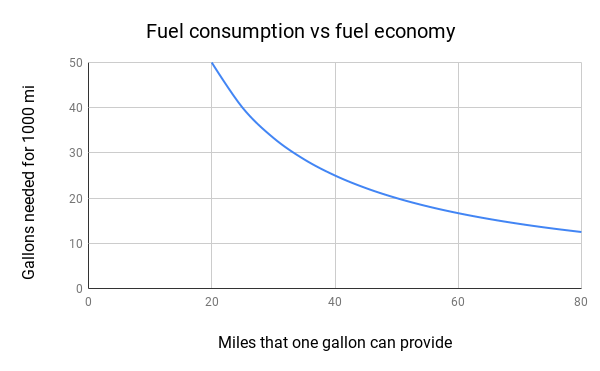Miles per gallon: Difference between revisions
No edit summary |
m (1 revision imported) |
||
| (4 intermediate revisions by 3 users not shown) | |||
| Line 1: | Line 1: | ||
[[Category:Done 2018-08-03]] | |||
<onlyinclude>'''Miles per gallon''' is a [[fuel | <onlyinclude>'''Miles per gallon''' (MPG) is a [[fuel economy]] rating determined by how far a car can travel on a gallon of [[gasoline]] or [[diesel]]. </onlyinclude> Although the metric version would be ''kilometres per litre'', MPG is adopted in many metric-system countries, like Canada. | ||
While it is both cheaper and better for the environment to achieve a higher MPG rating, there is a curve, that the EPA calls the "MPG Illusion" that shows the cost-benefits of increasing MPG decrease with higher rating. For example, to travel 1,000 miles, a car that gets 10 MPG will require 100 gallons of fuel. Conversely, a car that gets 15 MPG will require 67 gallons of fuel. In this case, an increase of just 5 MPG cuts fuel consumption by 33%. When a car gets 30 MPG, however, increasing its mileage to 35 MPG will only save 5 gallons of fuel over 1,000 miles. | |||
Because of this "MPG Illusion," car makers in both the United States and Canada are beginning to list their cars' mileage in fuel consumption per distance. In Canada, this is done in liters per 100 kilometers (L/100km), and in the USA, this is done in gallons per 100 miles (gal/100mi). | [[File:Fuel consumption vs fuel economy.png|600px|thumb|center|The graph above shows the "MPG Illusion." That fuel consumption does not decrease at a linear rate with MPG increase.<ref>EPA. (Accessed September 23, 2015). ''Fuel Consumption Rate'' [Online], Available: http://www.epa.gov/carlabel/electriclabelreadmore.htm</ref>]] | ||
Because of this "MPG Illusion," car makers in both the United States and Canada are beginning to list their cars' mileage in [[fuel consumption]] per distance. In Canada, this is done in liters per 100 kilometers (L/100km), and in the USA, this is done in gallons per 100 miles (gal/100mi). | |||
| Line 10: | Line 12: | ||
==Conversions== | ==Conversions== | ||
<html><br /> <iframe src=" | <html><br /> <iframe src="https://energyeducation.ca/simulations/converter/converter.php?defaultMeasure=Fuel Efficiency&defaultFrom=mile per gallon (US)&defaultTo=kilometer per litre" width="750" height="200" scrolling="no"> </iframe><br /> </html> | ||
==For Further Reading== | |||
*[[Fuel economy]] | |||
*[[Fuel consumption]] | |||
*[[Fuel economy savings]] | |||
*[[Energy for transportation by country]] | |||
*[[Kinetic energy]] | |||
*Or explore a [[Special:Random|random page]] | |||
==References== | ==References== | ||
{{reflist}} | {{reflist}} | ||
[[Category:Uploaded]] | [[Category:Uploaded]] | ||
Latest revision as of 22:23, 3 September 2018
Miles per gallon (MPG) is a fuel economy rating determined by how far a car can travel on a gallon of gasoline or diesel. Although the metric version would be kilometres per litre, MPG is adopted in many metric-system countries, like Canada.
While it is both cheaper and better for the environment to achieve a higher MPG rating, there is a curve, that the EPA calls the "MPG Illusion" that shows the cost-benefits of increasing MPG decrease with higher rating. For example, to travel 1,000 miles, a car that gets 10 MPG will require 100 gallons of fuel. Conversely, a car that gets 15 MPG will require 67 gallons of fuel. In this case, an increase of just 5 MPG cuts fuel consumption by 33%. When a car gets 30 MPG, however, increasing its mileage to 35 MPG will only save 5 gallons of fuel over 1,000 miles.

Because of this "MPG Illusion," car makers in both the United States and Canada are beginning to list their cars' mileage in fuel consumption per distance. In Canada, this is done in liters per 100 kilometers (L/100km), and in the USA, this is done in gallons per 100 miles (gal/100mi).
Read more about miles per gallon here
Conversions
For Further Reading
- Fuel economy
- Fuel consumption
- Fuel economy savings
- Energy for transportation by country
- Kinetic energy
- Or explore a random page
References
- ↑ EPA. (Accessed September 23, 2015). Fuel Consumption Rate [Online], Available: http://www.epa.gov/carlabel/electriclabelreadmore.htm

